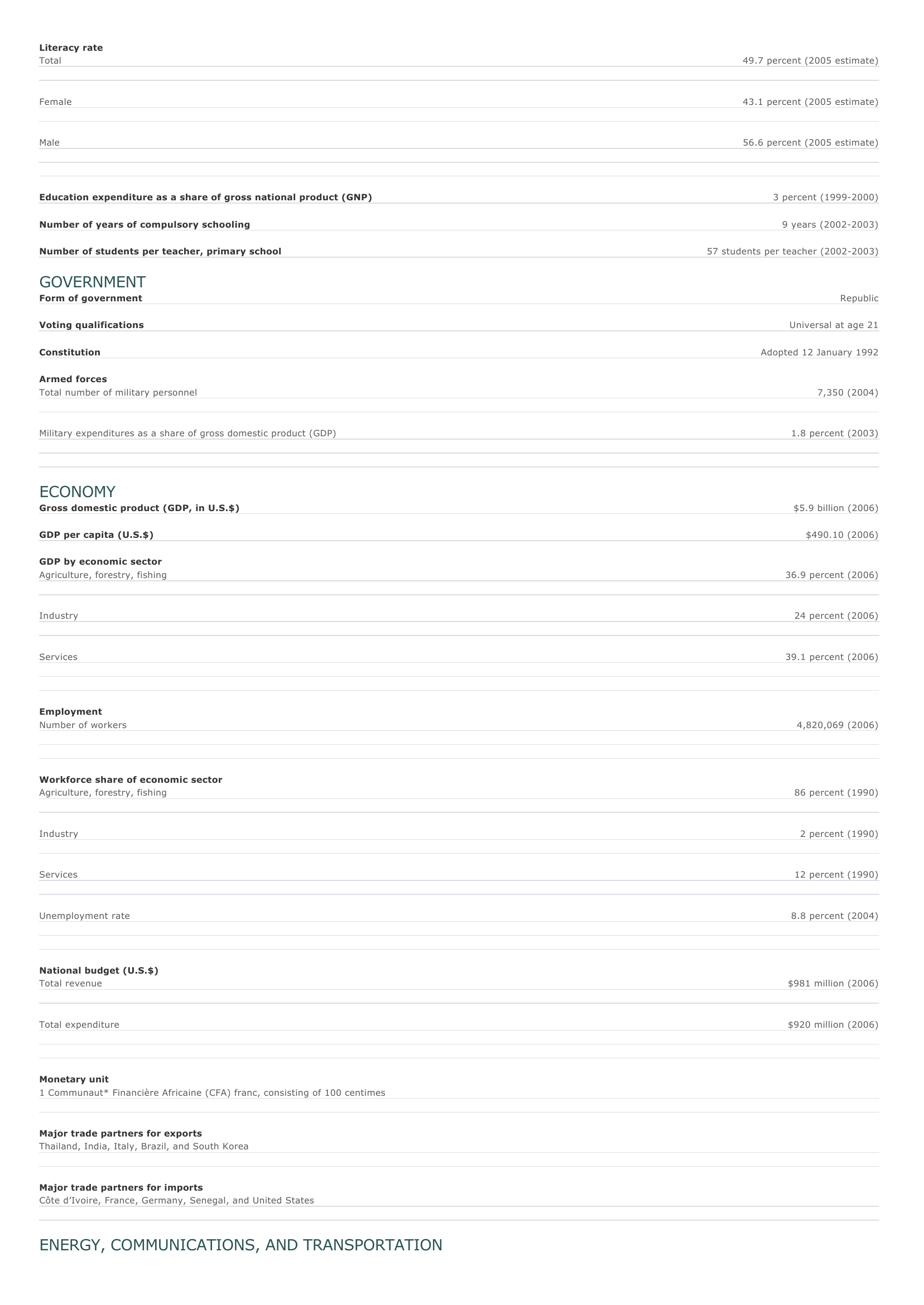
Mali Facts and Figures. BASIC FACTS Official name Capital Area Republic of Mali Bamako 1,240,192 sq km 478,841 sq mi PEOPLE Population 12,324,029 (2008 estimate) Population growth Population growth rate 2.73 percent (2008 estimate) Projected population in 2025 20,386,013 (2025 estimate) Projected population in 2050 40,002,414 (2050 estimate) Population density 10 persons per sq km (2008 estimate) 26 persons per sq mi (2008 estimate) Urban/rural distribution Share urban 34 percent (2005 estimate) Share rural 66 percent (2005 estimate) Largest cities, with population Bamako Ségou 1,264,000 (2003 estimate) 107,000 (1998) Ethnic groups Bambara, Fulani, Tuareg, Soninke, Senufo, Songhai, Mandinka (also known as Mandingo or Malinke), and others Languages French (official); Bambara and numerous other African languages Religious affiliations Muslim 81 percent Indigenous beliefs 16 percent Christian 2 percent O ther 1 percent HEALTH AND EDUCATION Life expectancy Total 49.9 years (2008 estimate) Female 51.9 years (2008 estimate) Male Infant mortality rate Population per physician Population per hospital bed 48 years (2008 estimate) 104 deaths per 1,000 live births (2008 estimate) 12,734 people (2004) 4,167 people (1998) Literacy rate Total 49.7 percent (2005 estimate) Female 43.1 percent (2005 estimate) Male 56.6 percent (2005 estimate) Education expenditure as a share of gross national product (GNP) Number of years of compulsory schooling Number of students per teacher, primary school 3 percent (1999-2000) 9 years (2002-2003) 57 students per teacher (2002-2003) GOVERNMENT Form of government Republic Voting qualifications Universal at age 21 Constitution Adopted 12 January 1992 Armed forces Total number of military personnel Military expenditures as a share of gross domestic product (GDP) 7,350 (2004) 1.8 percent (2003) ECONOMY Gross domestic product (GDP, in U.S.$) GDP per capita (U.S.$) $5.9 billion (2006) $490.10 (2006) GDP by economic sector Agriculture, forestry, fishing 36.9 percent (2006) I ndustry 24 percent (2006) Services 39.1 percent (2006) Employment Number of workers 4,820,069 (2006) Workforce share of economic sector Agriculture, forestry, fishing 86 percent (1990) I ndustry 2 percent (1990) Services 12 percent (1990) Unemployment rate 8.8 percent (2004) National budget (U.S.$) Total revenue $981 million (2006) Total expenditure $920 million (2006) Monetary unit 1 Communaut* Financière Africaine (CFA) franc, consisting of 100 centimes Major trade partners for exports Thailand, India, Italy, Brazil, and South Korea Major trade partners for imports Côte d'Ivoire, France, Germany, Senegal, and United States ENERGY, COMMUNICATIONS, AND TRANSPORTATION Electricity production Electricity from thermal sources 20.73 percent (2003 estimate) Electricity from hydroelectric sources 79.27 percent (2003 estimate) Electricity from nuclear sources 0 percent (2003 estimate) Electricity from geothermal, solar, and wind sources 0 percent (2003 estimate) Number of radios per 1,000 people 55 (1997) Number of telephones per 1,000 people 6 (2005) Number of televisions per 1,000 people 15 (2000 estimate) Number of Internet hosts per 10,000 people Daily newspaper circulation per 1,000 people Number of motor vehicles per 1,000 people Paved road as a share of total roads 0.17 (2003) 1 (1996) 4.5 (1997) 18 percent (2004) SOURCES Basic Facts and People sections Area data are from the statistical bureaus of individual countries. Population, population growth rate, and population projections are from the United States Census Bureau, International Programs Center, International Data Base (IDB) (www.census.gov). Urban and rural population data are from the Food and Agriculture Organization (FAO) of the United Nations (UN), FAOSTAT database (www.fao.org). Largest cities population data and political divisions data are from the statistical bureaus of individual countries. Ethnic divisions and religion data are largely from the latest Central Intelligence Agency (CIA) World Factbook and from various country censuses and reports. Language data are largely from the Ethnologue, Languages of the World, Summer Institute of Linguistics International (www.sil.org). Health and Education section Life expectancy and infant mortality data are from the United States Census Bureau, International Programs Center, International database (IDB) (www.census.gov). Population per physician and population per hospital bed data are from the World Health Organization (WHO) (www.who.int). Education data are from the United Nations Educational, Scientific and Cultural Organization (UNESCO) database (www.unesco.org). Government section Government, independence, legislature, constitution, highest court, and voting qualifications data are largely from various government Web sites, the latest Europa World Yearbook, and the latest Central Intelligence Agency (CIA) World Factbook. The armed forces data is from Military Balance. Economy section Gross domestic product (GDP), GDP per capita, GDP by economic sectors, employment, and national budget data are from the World Bank database (www.worldbank.org). Monetary unit, agriculture, mining, manufacturing, exports, imports, and major trade partner information is from the statistical bureaus of individual countries, latest Europa World Yearbook, and various United Nations and International Monetary Fund (IMF) publications. Energy, Communication, and Transportation section Electricity information is from the Energy Information Administration (EIA) database (www.eia.doe.gov). Radio, telephone, television, and newspaper information is from the United Nations Educational, Scientific and Cultural Organization (UNESCO) database (www.unesco.org). Internet hosts, motor vehicles, and road data are from the World Bank database (www.worldbank.org). Note Figures may not total 100 percent due to rounding. Microsoft ® Encarta ® 2009. © 1993-2008 Microsoft Corporation. All rights reserved.



































